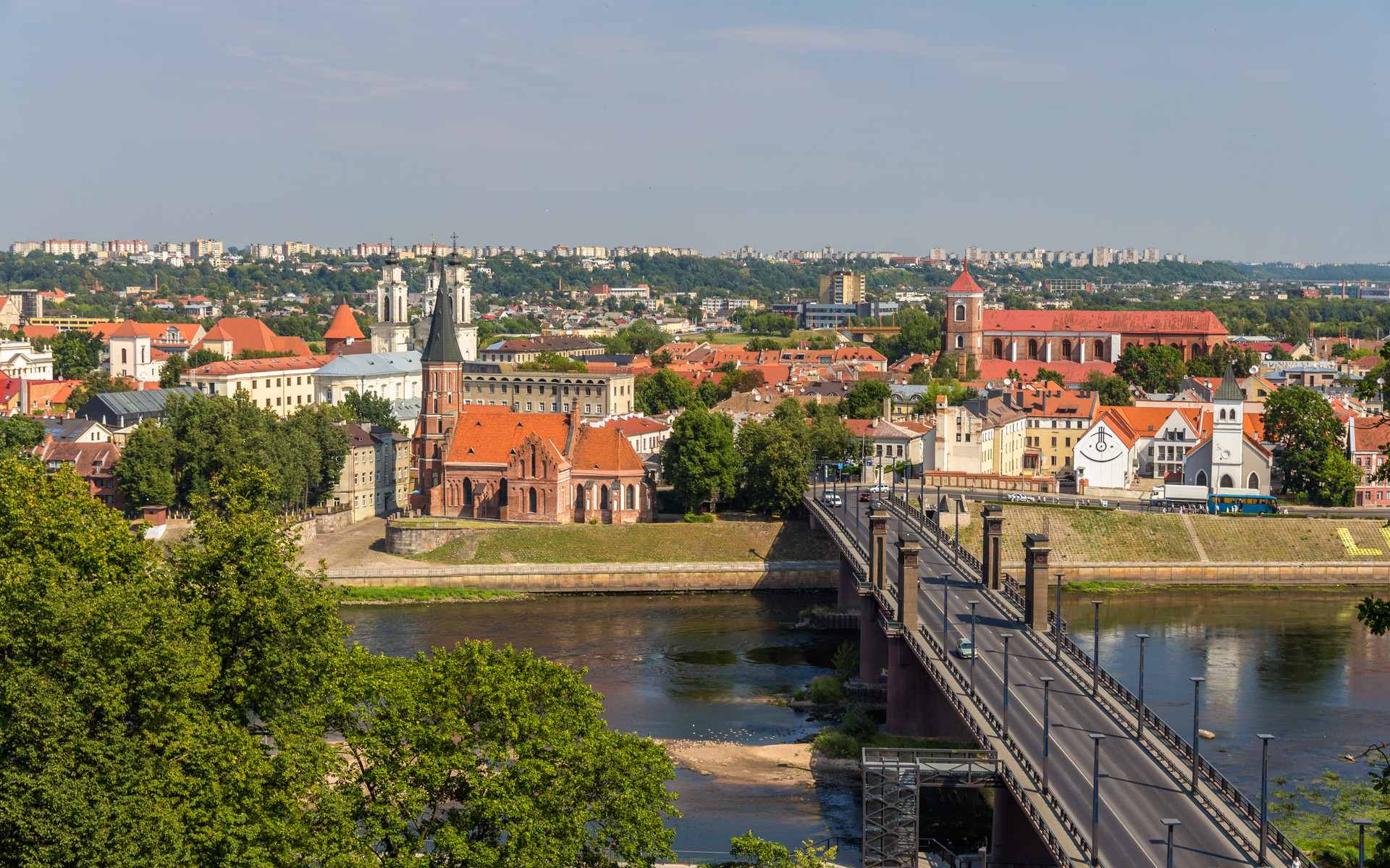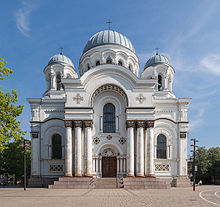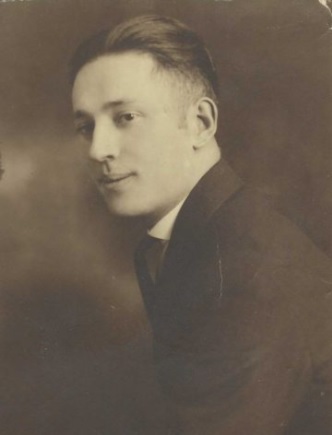When, in 2003, Lisa mentioned that we ought to go the Kaunas, Lithuania, where my father grew up, I was absolutely delighted. Of course, the “we” refers to Joni, me and Lisa. Joni, who doesn’t like to fly, opted out; flying over the ocean wasn’t her cup of tea. Two years later, after detailed prep and planning – especially on Lisa’s part – we left on our ten-day venture.
While pictures tell their own story, what can’t be seen are the thoughts and connections resulting from being in the former Eastern (Communist) Bloc and the former Russian Empire. Some of these are expressed in the following accounts.
Kaunas
After our prop-plane flight from Helsinki landed in Vilnius, we were met by a driver who took us to west to Kaunas.

As we were leaving Vilnius and later approaching Kaunas, we could see huge cell-phone towers piercing the sky.
They broke my spell of thinking we were touring the Old World. Rather than being in late 19th or early 20th century venues, we were seeing historic buildings juxtaposed to 21st century inhabitants and technology.

This was made strikingly clear while walking The Laisves Alega (Liberty Boulevard), a pedestrian promenade leading from

a neo-byzantine church on one end

to the wonderful Old Town on the other. Along the way, we passed old structures and new stores and soon spotted a TV dish high on the side of a century-old building.

Moments later we saw students just coming out of school who were on their cell-phones. For some reason, I didn’t expect to see so vividly the old and the new in an area so controlled by dictators not that many years ago. (In 1991, the Baltic states proclaimed their independence and succession from the collapsing Soviet Union.) What a difference a decade had made.

As we continued walking I was on a mission to find an address on Laisves that I had discovered on the back of a photograph in my parents old photo album.


? Shokhor 
Harry Schock
Judging from their facial similarities, I was convinced the woman’s photo had to be that of my father’s sister.

Before long, I said to Lisa, “there it is, number 48.” The address was barely visiable beneath the extended awning. A century later the building was still there, now housing a bakery. I stood there thinking that my father and his family walked here a hundred years before and now we were standing on the very spot. We had to go in! I wanted to ask if anyone remembered the photographic studio. As expected, no one had. But at least a connection had been made in my mind .
Following our walk and seeing the Old Town, we headed back to the hotel. After an overnight flight to Helsinki, another that morning to Vilnius and then our walk, we decided to have dinner on the hotel’s patio. That decision partially opened a door into our family’s history.

As we were finishing dinner, the owner of the hotel stopped by the table to asked how everything was. I said fine and that I had a question. He obliged with “of course.” I told him about hearing my father say “Slobadka” but never knew what or who he was referring to. The owner said, “just a moment, I’ll be right back.” We had no idea why he left but waited patiently. When he returned, he had a map in hand, opened it and pointed to a area just north of the confluence of the Nemunas and Neris rivers .

He then explained that the area he was pointing to, Vilijampolė, had been known as Slabodka during the Russian Empire. No doubt that had to be where my father had grown up. Our introduction to Lithuanian history was enhanced by our tour guide Regina who met us the next morning for a tour of Kaunas.

When we told her about our previous evening’s discovery, she said “Let’s go there”. I was really excited as we entered her car for the short drive to the bridge and across the Neris into Vilijampolė. Our first stop was at the entrance to what had been the Jewish Ghetto where the Nazi’s held 29,000 Lithuanian Jews during the Holocaust. The gate to the ghetto is marked by a monument, its simplicity a contrast to the enormity of the horrors that took the lives of some many and depleted the Jewish population, one that has never recovered.

As we continued on, we passed slanting wooden structures that must have been there for over a century. In my mind I again imagined my father walking by as he and his family headed into Old Town Kaunas.

Soon we arrived at the Synagogue in Vilijampolė and our guide took us inside where we were greeted by a few seated elders with “Shalom.”

There we stood before another memorial to the victims of the Holocaust.


That afternoon I took a walk to see the Kaunas Synagogue and discovered it had been a site of great strife when Jewish factions grew apart and the prayer house closed its doors.
Our guide also took us to Kaunas Castle and, before we knew it, our eventful two days in Kaunas ended as we headed back to Vilnius to join our Vytis tour group that evening.
(Photos Kaunas)
Meeting our group and our tour guide Ona at the hotel started our second leg of our journey. When we assembled the following morning to begin our exploration of Vilnius, it was fun joining with other tours, from Germany and Italy, while busing from place to place and hearing their guides’ explanations along the way. I loved mellifluous voice of the Italian guide. That was a treat even though I couldn’t understand a word he said. For me, it was similar to enjoying an unfamiliar Italian opera while not understanding the language or knowing the plot. We were now full-blow tourists and enjoying the sights and sounds and tastes of the Lithuanian capital, a city more than double the size of Kaunas.

Our visit to University was special. The photos include the remarkable art work in the library’s beautiful rooms.
While our group was walking in the city shortly before noon, our guide stopped to say that those who wanted could follow her into a former Jewish Ghetto area while the others could take a lunch break if they wished. Lisa and I followed.

Here was another reminder of the local Jewish population decimated at the hands of the Nazis during the Second World War.
In the afternoon our bus took the three groups to Trakai, a half-hour west of Vilnius. On our way, Ona pointed to a forrested area where the Nazi’s had committed thousands of executions. Knowing that Lithuania was a Catholic country, I had to ask Ona privately how the citizens viewed the remaining Jewish population. I thought her simple answer was profound especially given the way she said it: “citizens.” My interpretation was: they belong. To me that was powerful!
(Photos: Kaunas)
(Photos) Vilnius
(Photos) Trakai
After our day in Vilnius ended, we were primed for our bus trip to Riga, the capital of Latvia. On our way north through the Lituanian countryside we had a rest stop an an amazing farm museum.

This photo collection says it all. (ctrl+F5 for Presentation mode)